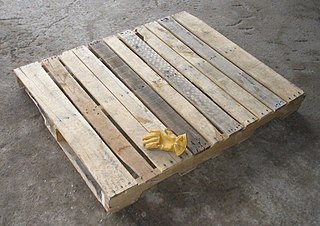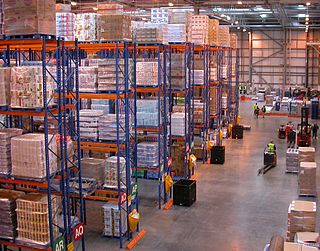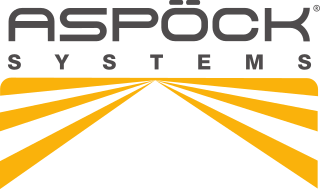
Logistics is the part of supply chain management that deals with the efficient forward and reverse flow of goods, services, and related information from the point of origin to the point of consumption according to the needs of customers. Logistics management is a component that holds the supply chain together. The resources managed in logistics may include tangible goods such as materials, equipment, and supplies, as well as food and other consumable items.

A forklift is a powered industrial truck used to lift and move materials over short distances. The forklift was developed in the early 20th century by various companies, including Clark, which made transmissions, and Yale & Towne Manufacturing, which made hoists. Since World War II, the use and development of the forklift truck have greatly expanded worldwide. Forklifts have become an indispensable piece of equipment in manufacturing and warehousing. In 2013, the top 20 manufacturers worldwide posted sales of $30.4 billion, with 944,405 machines sold.

A warehouse is a building for storing goods. Warehouses are used by manufacturers, importers, exporters, wholesalers, transport businesses, customs, etc. They are usually large plain buildings in industrial parks on the outskirts of cities, towns, or villages.

A pallet is a flat transport structure, which supports goods in a stable fashion while being lifted by a forklift, a pallet jack, a front loader, a jacking device, or an erect crane. Many pallets can handle a load of 1,000 kg (2,200 lb). While most pallets are wooden, pallets can also be made of plastic, metal, paper, and recycled materials.

A distribution center for a set of products is a warehouse or other specialized building, often with refrigeration or air conditioning, which is stocked with products (goods) to be redistributed to retailers, to wholesalers, or directly to consumers. A distribution center is a principal part, the order processing element, of the entire order fulfillment process. Distribution centers are usually thought of as being demand driven. A distribution center can also be called a warehouse, a DC, a fulfillment center, a cross-dock facility, a bulk break center, and a package handling center. The name by which the distribution center is known is commonly based on the purpose of the operation. For example, a "retail distribution center" normally distributes goods to retail stores, an "order fulfillment center" commonly distributes goods directly to consumers, and a cross-dock facility stores little or no product but distributes goods to other destinations.

Siltronic AG is a manufacturer of wafers made of hyperpure silicon, the basis for modern micro- and nanotechnology. The Munich-based company is one of the world's leading manufacturers of wafers for the semiconductor industry.

Kion Group AG is a German multinational manufacturer of materials handling equipment, with its headquarters in Frankfurt, Hesse, Germany. Its principal products are intralogistics, warehouse automation equipment, and industrial (forklift) trucks. KION Group was founded in 2006 by the demerger of Linde's materials handling equipment operations. It is the world's second-largest manufacturer of forklifts measured by revenues.

Material handling equipment (MHE) is mechanical equipment used for the movement, storage, control, and protection of materials, goods and products throughout the process of manufacturing, distribution, consumption, and disposal. The different types of equipment can be classified into four major categories: transport equipment, positioning equipment, unit load formation equipment, and storage equipment.

The term unit load refers to the size of an assemblage into which a number of individual items are combined for ease of storage and handling, for example a pallet load represents a unit load which can be moved easily with a pallet jack or forklift truck, or a container load represents a unit for shipping purposes. A unit load can be packed tightly into a warehouse rack, intermodal container, truck or boxcars, yet can be easily broken apart at a distribution point, usually a distribution center, wholesaler, or retail store for sale to consumers or for use.

Material handling involves short-distance movement within the confines of a building or between a building and a transportation vehicle. It uses a wide range of manual, semi-automated, and automated equipment and includes consideration of the protection, storage, and control of materials throughout their manufacturing, warehousing, distribution, consumption, and disposal. Material handling can be used to create time and place utility through the handling, storage, and control of waste, as distinct from manufacturing, which creates form utility by changing the shape, form, and makeup of material.

Crown Equipment Corporation is a privately held American manufacturer of powered industrial forklift trucks based in Ohio. The fifth-largest such manufacturer, Crown had $4.69 billion in worldwide sales revenue for fiscal year 2022. The company was founded in 1945.
Mitsubishi Caterpillar Forklifts, Inc. is a group of multinational companies that were formed under a joint venture between Mitsubishi Heavy Industries (MHI) and Caterpillar Inc. in order to manufacture and market trucks. The group manufactures and distributes Cat Lift Trucks, Mitsubishi Forklift Trucks and Jungheinrich warehouse products to the material handling industry.

Krones AG is a German packaging and bottling machine manufacturer. It produces lines for filling beverages in plastic and glass bottles or beverage cans. The company manufactures stretch blow-moulding machines for producing polyethylene terephthalate (PET) bottles, plus fillers, labellers, bottle washers, pasteurisers, inspectors, packers and palletisers. This product portfolio is complemented by material flow systems and process technology for producing beverages for breweries, dairies and soft-drink companies.
Hamburger Hafen und Logistik AG, known until 2005 as Hamburger Hafen- und Lagerhaus-Aktiengesellschaft, and prior to that as Hamburger Freihafen-Lagerhaus Gesellschaft (HFLG) since 1885, is a German logistics and transportation company specialising in port throughput and container and transport logistics.

Shelf-ready packaging (SRP) and retail-ready packaging (RRP) refers to the packaging of a product so that it is delivered to a retailer in packaging which is optimized for efficient stocking and sale.
Gerry Weber International GmbH is a German fashion manufacturer and retailer based in Halle (Westf.), North Rhine-Westphalia. The business which was established in 1973 as Hatex KG by Udo Hardieck and Gerhard Weber is primarily known for its ladies' collections. Shares were listed on the SDAX index, previously on the more important MDAX index of the Frankfurt Stock Exchange. The company is led by three managing directors.

Ceconomy AG is an international retail company headquartered in Düsseldorf, Germany. Its history goes back to the Metro Group. Ceconomy operates more than 1,000 consumer electronics stores in twelve countries. In addition to MediaMarkt and Saturn, the group owns Deutsche Technikberatung. Approximately 32.5% of its sales are generated online.

Grenke AG is a German manufacturer-independent leasing company which is specialized in office communication-products, including printers, copiers, telephone systems, servers and laptop computers. Besides its leasing-activities, Grenke makes a notable portion of its revenue with factoring services. By acquiring the German private bank Hesse Newman in 2009, the company obtained a banking license. The most important markets for the company are Germany, France and Italy.

Michael Lohscheller is a business man, who worked as management control system for Jungheinrich, CFO at Mitsubishi Motors, CFO at Volkswagen Group, CEO at Opel and then VinFast of Vingroup from Vietnam.

Aspöck Systems is an internationally active supplier of the vehicle industry in the field of lighting technology based in Peuerbach, Upper Austria. The family-owned company manufactures lighting systems for cars, truck and car trailers, agricultural and construction machinery, caravans and motorcycles in Europe.
















